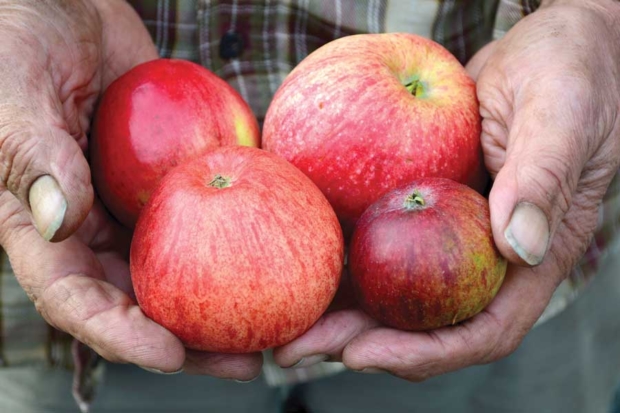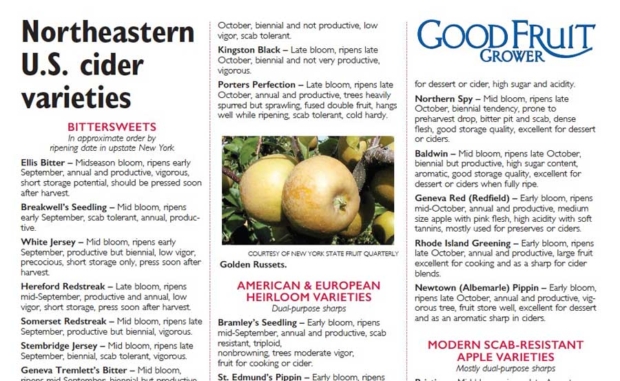
The four apples pictured here in grower Steve Wood’s hands are, clockwise from the bottom right, Dabinett, Ellis Bitter, Major and Foxwhelp. (Courtesy Brenda Bailey)
This story has been updated to reflect a correction.
Increasing interest in hard ciders and a critical shortage of some varieties of cider apples in the U.S., particularly for bittersweet and bittersharp varieties, could provide apple growers a new market.
There is huge demand for high-tannin cider varieties used in hard cider. One of the reasons for the shortage is the huge boom in demand for hard cider — increases of 78 percent, 63 percent and 49 percent from 2012 through 2014 — before demand fell to just a 10.8 percent increase in 2015.
In addition, only a few of the new cideries founded to serve that demand have expertise in growing apples or own productive orchards.
Steve Wood, co-owner with his wife Louise of Poverty Lane Orchards and Farnum Hill Ciders in Lebanon, New Hampshire, said he gets $24 per bushel f.o.b. from his loading dock for his cider apples. “We have a profitable market selling apples to other cider makers,” he said.
Ian Merwin, a retired Cornell University horticulture professor turned grower and cider maker, agreed.
“People are getting $400 per 20-bushel bin, if you have the right varieties,” said the Trumansburg, New York, owner and operator of the 64-acre Black Diamond Farm. “It’s not a guaranteed $500 a bin, but it will be a good 10 years before the supply of heirloom and cider varieties equals demand.”
The market
According to The Cyder Market’s Cider Maker Survey, there were 542 cider makers in the United States as of December 2015. That’s a 30 percent increase over the previous year.
New York leads the country in the number of cider makers at 65, according to the survey data. Merwin estimates the number to be higher, around 75, with half of them working under farm winery licenses.
Of interest to those looking to enter the cider apple sales business: Many cideries own orchards, but the majority neither own nor lease orchards, instead purchasing or contracting for fruit and juice from others.
Nearly one-quarter of all cider makers claim to use at least one type of heirloom apple in their products. About 10 percent reported they use organically grown fruit.
For survey purposes, “organic” was defined as either certified organic or a growers’ claims to use accepted organic practices to produce fruit.
Management concerns
For veteran orchardists, growing cider apples is not that different from growing dessert apples. However, new growers shouldn’t jump right in to bittersweet and bittersharp production, Merwin said.
“It’s better to start with growing dual-purpose heirlooms because of some of the special challenges that lie with the others,” he said.
Cider apples tend to be smaller, more acidic and to have more tannins. They can set in clusters, are harder to thin and tend toward biennial yields.
Some trees are extremely vigorous and others are very spurry. Plantings should be organized by bloom times.
“Many are late-blooming, as much as three weeks later than Fujis,” he said. “Timing of chemical thinning sprays is critical. You don’t want to be running all over your orchards turning the sprayer on and off because your plantings aren’t organized according to bloom.”
About half of European bittersweets bloom even later than Northern Spys, he said. They were probably selected that way to reduce damage by Europe’s spring frosts, which are sometimes later than those in the U.S.
So, when the temperatures dropped to 5 degrees Fahrenheit in New York’s Finger Lakes region in early April, Merwin experienced significant bud damage on his noncider varieties. His bittersweets, however, were still at silver tip and were unaffected.
Rootstocks
When it comes to rootstocks for cider varieties, Wood said he chooses those with which he’s most familiar. He says his current cider workhorses are EMLA111 and B9, followed by EMLA106 and EMLA26. He’s trying B118 for the first time next year. For the most part, his decision is driven by how he harvests his cider varieties: He shakes his trees.
“I’m looking for deep-rooted, sturdy, precocious rootstock that has a strong graft union and is capable of being shaken,” he said. He shakes his trees because he wants his apples to achieve a very high degree of ripeness. “It’s way beyond the appropriate ripeness of an apple that is hand-harvested from the tree for storage or packing.”
Merwin advocates using full-dwarf rootstocks. “Smaller trees are easier to prune, spray and harvest, and fruit quality is consistently better on more slender trees,” he said.
Big standard trees tend to suffer more from pest and diseases, and their crowns are so dense that the best apples are on the outside and the top, while fruit inside the canopy is denied light and does not develop its full flavor, he said.
“In dwarf trees — at 10- to 12-feet tall and 5-feet wide at the base — every apple gets good sun. An open tree canopy is the easiest to get in a dwarf orchard, and you will get more sugar, pigment and higher quality,” he said.
Merwin allows that high-density plantings are very costly to establish — as much as $25,000 per acre with tree and trellis costs, management and irrigation.
However, returns on investment in their high-density, dwarf plantings are five years versus 15 years for low-density, semi-dwarf orchards.
“There is little data to support the argument of not being able to spend $20,000 to $30,000 per acre to establish an orchard for processing apples if you are growing high-priced cider varieties,” he said.
However, Merwin concedes there may be times when nondwarfing rootstock are necessary, including in colder growing regions with shorter growing seasons, or at sites with gravelly, shallow or droughty soils.
Another place where they make sense are organic orchards where tree-row weed control is difficult and where trees often experience nutrient stress.
“The truth is, there is no single rootstock or planting system best for all sites or growers,” he said. •
– Learn more about cider varieties by reading “Two growers weigh in cider varieties.”
– by Dave Weinstock
Correction: This story originally reported that Malling 9 was used as a rootstock. The text has been updated to correctly list the rootstocks he uses.
Related: Northeastern U.S. cider varieties (PDF).







This is great, but I must have slurred my words when talking about rootstocks. We would never plant cider on M9, and we’re trying B118 for the first time next year. Our current cider workhorses are EMLA111 and B9, followed by EMLA106 and EMLA26.
Steve Wood.
Steve, Thanks for the update! We have corrected the text here.